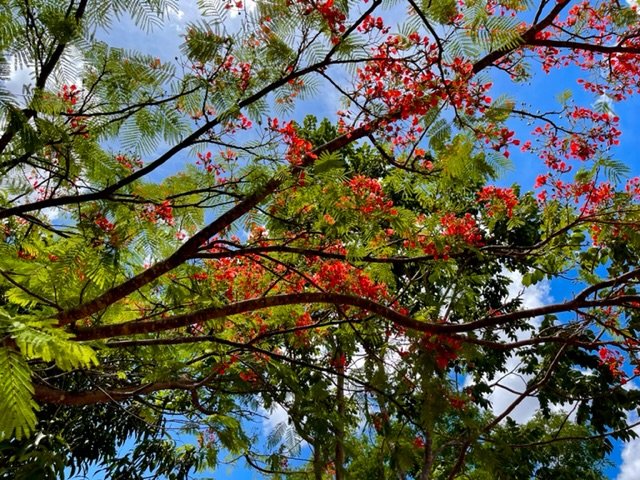Parque da Cidade—Brasília’s treasured urban park
Brasília is not just modernist reinforced concrete architecture—it is also wide green spaces and limitless trees, many of them fruit-bearing and available to anyone for the picking in season. One of the capital city’s treasures is the Parque da Cidade, city park.
I went to Parque da Cidade a couple of days ago in search of bright red Royal poinciana trees (called flamboyants in Brazil, directly from the French name) to photograph. I didn’t have much luck finding poincianas, but I did wander around for an hour, walking on the paved trails, cautiously going off-piste to explore, watching where I stepped since disturbing a fire ant nest would be a big mistake. Walking off the paved track means staining your shoes with the dark red dirt, but I finally learned my lesson and bought colorful athletic shoes that won’t show it so easily.
I parked my car in the north parking lot, entering by the big amusement park with its Ferris wheel and carnival rides, which was closed since it was a weekday morning. The paved walking track took me past a cluster of gazebo-tents where massage therapists were at work. Then a bit further along, a neatly tended community garden. There were jacas with their curious huge fruit hanging by stems from the tree trunks. This area is a location for yoga classes on weekends, and other activities for bem estar, well-being.
Cyclists have a separate paved route, with the walking trail in parallel. It was a warm morning and not too busy, so cyclists had plenty of space to move at their various paces. There are bathroom facilities at intervals along the paths, in the modernist style with geometric tile facings. I noticed police presence (well, one police officer) at every one, and while old-fashioned and cynical Americans might guess this was aimed at discouraging sexual activity, I think the main goal is preventing plain old robberies and assaults.
My wandering took me past an autodrome, a sort of go-kart park with extensive loops for drivers to experience “Formula One,” at least that’s what the signs said. This was also closed on a quiet weekday morning. There is a large artificial lake which winds around one quarter of the length of the park. I sat on a concrete pedestal at a deserted picnic area and listened to the birdsong in the shade of the surrounding mango trees. The sun was climbing in the sky; I found my way back to my car and in a flash was back in the city.
The park was inaugurated in 1978 and renamed for the wife of President Juscelino Kubitschek in 1997. President JK, as he was known, impelled the building of Brasília as the new capital of Brazil in a miracle of rapid construction in the late 1950s. Dona Sarah Kubitschek was first lady during her husband’s term of office; she is renowned for her commitment to social programs to help the people, including rehabilitation centers and programs for women, children and the poor. My sister-in-law developed polio as a baby and my mother-in-law has recounted to me how Dona Sarah personally offered the opportunity for her baby to be moved from Brasília to São Paulo to receive therapy, which was not available in the newly constructed capital in the early 1960s (she recovered completely). Driving around Brasília today, you see signs for several rehabilitation and neurologic institutes charitably founded by and named after Dona Sarah.
Yesterday I was engaging in one of my favorite activities, driving around lost with a GPS that somehow always manages to have no signal in this situation. I cognitively reframe this problem as an opportunity to learn about new places and begin to find my way around the city. Only all my years of driving around Brazil have made me able to rationalize this. As long as I have enough gas, sooner or later I will recognize something and find my way. In this case, I stumbled across the south side of the park—maybe south, maybe west, who knows? Certainly not me, with my total lack of inherent navigational abilities. As they say, I was hiding behind the door when God was passing out a sense of direction.
The positive of being completely lost and having to drive the perimeter of Parque da Cidade was that it made me realize how truly huge it is. At 420 hectares it is larger than New York City’s Central Park, which is only 320 hectares. Parque da Cidade is one of the largest urban parks in the world, and the largest in Latin America. Brasília’s treasure, a green oasis in the middle of the busy city.



